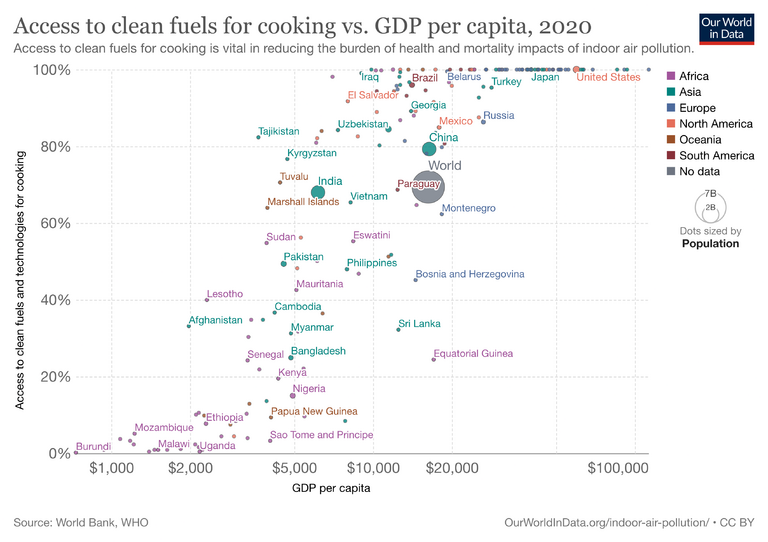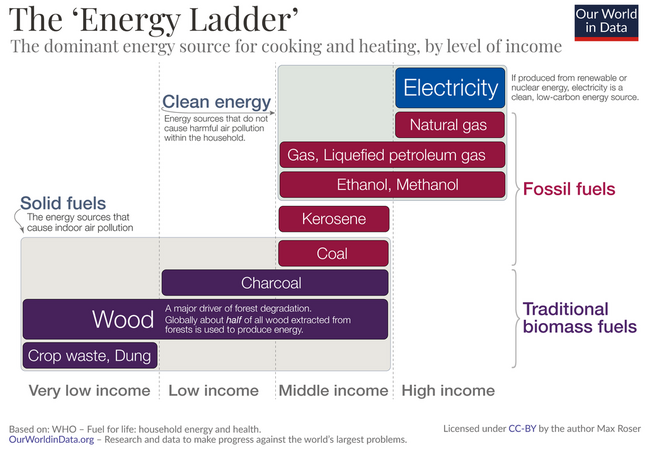Solid Fuels and Health
Original Editor - Lucinda hampton
Top Contributors - Lucinda hampton and Kim Jackson
Introduction[edit | edit source]
Globally, around 40% of the population (> 3 billion people) depends on burning solid fuel (e.g., biomass fuel, coal, and related fuel) for their household life, primarily reason for cooking and heating. Burning solid fuels on open fires or simple stoves fills the room with smoke and toxic chemicals. These energy sources expose those in the household (usually the women and children) to pollution levels that are far greater than in that of the worlds most polluted cities. Solid fuels, generating household air pollution, was associated with more than 2 million deaths in 2019. These deaths are preventable by ensuring everyone has access to clean fuels.[1][2][3]
Inhaling the soot and ash particles that solid fuels emit when burned is harmful. Fine particles (at most, 2.5 micrometers in diameter) travel deep into the lungs[4]. With long-term exposure, they can lead to for:
- Children: pneumonia and other acute lower respiratory diseases among children
- Adults: chronic obstructive pulmonary disease, stroke, coronary arterial disease, lung cancer[5] and cognitive decline.
Using solid fuels for cooking and heating also doubles the risk of all-cause mortality compared to those who singly use clean fuels.[2]
Global Needs[edit | edit source]
Unless global and national investments in clean energy access and adoption increase substantially this decade, household particulate concentrations will remain far above acceptable levels. There are substantial opportunities to improve air quality and avert child mortality associated with household air pollution and that of adults. Women and children, typically responsible for household chores (such as cooking) bear the greatest health burden from the use of polluting fuels in homes[6].
On a personal level people can be made aware of the dangers.
- One of the main ways to reduce indoor air pollution is by ensuring proper ventilation. Proper ventilation helps remove polluted indoor air and replace it with fresh, clean air from outside. This may be possible via minor changes.
- Rearranging the household structure may help e.g. having children and babies not sleeping in cooking areas or poorly ventilated areas.
- Trying to spend more time outside if indoor hours constitute a large part of the day.[1]
Energy Ladder[edit | edit source]
'Energy Ladder' shows the dominant sources of household energy at different levels of income. From very low incomes on the left, to high incomes on the right. The poorest households burn wood and other biomass, like crop waste and dried dung. Those who can afford it cook and heat with charcoal or coal.
In countries in which the average income is less than $10,000 less than half of the population has access to clean energy.[3].
See also Effects of Air Pollution on Neurodegeneration: Implications for Physiotherapy
References[edit | edit source]
- ↑ 1.0 1.1 Frostad JJ, Nguyen QP, Baumann MM, Blacker BF, Marczak LB, Deshpande A, Wiens KE, LeGrand KE, Johnson KB, Abbasi-Kangevari M, Abdoli A. Mapping development and health effects of cooking with solid fuels in low-income and middle-income countries, 2000–18: a geospatial modelling study. The Lancet Global Health. 2022 Oct 1;10(10):e1395-411. Available: https://www.sciencedirect.com/science/article/pii/S2214109X22003321(accessed 27.120.2022)
- ↑ 2.0 2.1 Yang Y, Liu Y, Peng L, Zhang S, Yuan C, Li W, Liu Z, Ma Y. Cooking or heating with solid fuels increased the all-cause mortality risk among mid-aged and elderly People in China. Environmental Health. 2022 Dec;21(1):1-9. Available:https://ehjournal.biomedcentral.com/articles/10.1186/s12940-022-00903-6#Sec1 (accessed 27.10.2022)
- ↑ 3.0 3.1 Our world in data The ‘Energy Ladder’: What energy sources do people on different incomes rely on? Available:The ‘Energy Ladder’:https://ourworldindata.org/energy-ladder (accessed 28.10.2022)
- ↑ Witman, S. (2018), Solid-fuel use puts human health at risk, Eos, 99, Available:https://eos.org/research-spotlights/solid-fuel-use-puts-human-health-at-risk . Published on 15 March 2018.
- ↑ WHO Populations using solid fuels Available:https://www.who.int/data/gho/indicator-metadata-registry/imr-details/318 (accessed 27.10.2022)
- ↑ WHO Household air pollution and health Available:https://www.who.int/news-room/fact-sheets/detail/household-air-pollution-and-health (accessed 28.9.2022)









